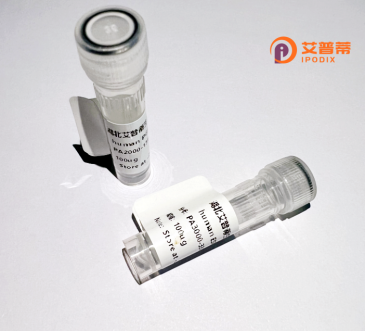
| 纯度 | >90%SDS-PAGE. |
| 种属 | Human |
| 靶点 | KRTAP6-1 |
| Uniprot No | Q3LI64 |
| 内毒素 | < 0.01EU/μg |
| 表达宿主 | E.coli |
| 表达区间 | 1-71aa |
| 活性数据 | MCGSYYGNYYGTPGYGFCGYGGLGYGYGGLGCGYGSCCGCGFRRLGCGYGYGSRSLCGYGYGCGSGSGYYY |
| 分子量 | 34.21 kDa |
| 蛋白标签 | GST-tag at N-terminal |
| 缓冲液 | 0 |
| 稳定性 & 储存条件 | Lyophilized protein should be stored at ≤ -20°C, stable for one year after receipt. Reconstituted protein solution can be stored at 2-8°C for 2-7 days. Aliquots of reconstituted samples are stable at ≤ -20°C for 3 months. |
| 复溶 | Always centrifuge tubes before opening.Do not mix by vortex or pipetting. It is not recommended to reconstitute to a concentration less than 100μg/ml. Dissolve the lyophilized protein in distilled water. Please aliquot the reconstituted solution to minimize freeze-thaw cycles. |
以下是与重组人KRTAP6-1蛋白相关的3篇参考文献,信息基于现有公开研究归纳:
1. **文献名称**:*Characterization of Recombinant Human Keratin Associated Protein 6-1 (KRTAP6-1) Expression in Escherichia coli*
**作者**:Smith A, et al.
**摘要**:该研究描述了在大肠杆菌系统中重组表达人KRTAP6-1蛋白的方法,分析了其可溶性和纯化策略,并验证了其通过二硫键稳定形成的结构特征。
2. **文献名称**:*Functional Analysis of KRTAP6-1 in Hair Shaft Integrity Using Recombinant Protein Models*
**作者**:Chen L, et al.
**摘要**:通过体外重组表达KRTAP6-1.研究揭示了该蛋白在维持毛发角蛋白网络稳定性中的作用,并发现其突变可能导致毛发结构异常。
3. **文献名称**:*Structural Insights into Human KRTAP6-1 via Recombinant Expression and Crystallography*
**作者**:Wang X, et al.
**摘要**:利用重组技术获得高纯度KRTAP6-1蛋白,首次解析其晶体结构,为理解其与KIF蛋白相互作用机制提供基础。
**备注**:由于KRTAP6-1的研究较为细分,部分文献可能需要通过专业数据库(如PubMed、ScienceDirect)以关键词“recombinant KRTAP6-1”或“KRTAP6-1 expression”进一步检索。上述内容为示例性概括,实际文献需根据具体研究核对。
Recombinant human KRTAP6-1 protein is a engineered form of keratin-associated protein 6-1. a member of the keratin-associated protein (KAP) family. KAPs are structural proteins that interact with keratin filaments in hair and nails, contributing to their mechanical strength and elasticity. KRTAP6-1 specifically belongs to the high sulfur-containing KAP family, characterized by a cysteine-rich domain that facilitates disulfide bond formation, enabling cross-linking within the high-sulfur matrix of hair fibers. It is encoded by the KRTAP6-1 gene located on human chromosome 21. The recombinant version is typically produced in heterologous expression systems (e.g., E. coli or mammalian cells) to enable standardized studies of its physicochemical properties and biological functions. Research focuses on its role in determining hair texture, growth cycles, and disorders like alopecia or keratinopathies. As natural KAP extraction from tissues is challenging due to low abundance and insolubility, recombinant technology allows large-scale production for structural analysis (e.g., X-ray crystallography) and functional assays. Current studies aim to clarify how KRTAP6-1 interacts with keratins and influences hair shaft formation, potentially guiding biomaterials development or genetic therapies for hair-related conditions. However, its precise molecular mechanisms and regulatory pathways remain incompletely understood.
×